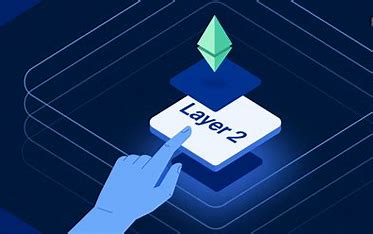Layer 1 vs. Layer 2: A Comprehensive Guide to Blockchain Layers
 Navya Srivastava
Navya Srivastava
Introduction
In the world of cryptocurrency, the blockchain is often likened to a digital ledger. It's a decentralized database that records transactions across a network of computers. This distributed nature ensures security and transparency. But to fully grasp how blockchains work, we need to delve into their foundational layer: Layer 1.
While Layer 1 (L1) blockchains provide the fundamental framework for decentralized applications, they often face limitations in terms of scalability and transaction speed. This is where Layer 2 (L2) solutions come into play. L2s are designed to alleviate the burden on L1 networks, enabling faster, cheaper, and more efficient transactions.
What is Layer 1 Blockchain?
Layer 1 (L1) blockchain is the most fundamental layer of the blockchain technology stack. It's the bedrock upon which other layers and applications are built. Think of it as the highway system for the blockchain world. L1 blockchains are responsible for:
Transaction processing: They validate and execute transactions on the network.
Consensus mechanisms: They ensure agreement among network participants about the state of the blockchain.
Smart contract execution: For blockchains like Ethereum, they support the execution of self-executing contracts with predefined terms.
Key Components of Layer 1 Blockchains
Consensus Mechanism: This determines how nodes on the network agree on the validity of transactions and the order in which they are added to the blockchain. Popular consensus mechanisms include:
Proof of Work (PoW): This requires miners to solve complex computational puzzles to verify transactions and create new blocks. Bitcoin uses PoW.
Proof of Stake (PoS): Instead of mining, validators stake their cryptocurrency to participate in the consensus process. The more tokens a validator stakes, the higher their chance of being selected to create the next block. Ethereum transitioned from PoW to PoS in 2022.
Delegated Proof of Stake (DPoS): This involves electing delegates to represent stakeholders and participate in the consensus process.
Transaction Validation: L1 blockchains have built-in rules and algorithms to verify the validity of transactions. This includes checking for sufficient funds, preventing double-spending, and ensuring that transactions adhere to network protocols.
Smart Contracts: While not all L1 blockchains support them, smart contracts are self-executing contracts with terms directly written into code. They can automate processes, reduce intermediaries, and enable new types of applications.
Popular Layer 1 Blockchains
Bitcoin: The pioneer of blockchain technology, Bitcoin is primarily known for its digital currency, BTC. It uses PoW for consensus and has a limited supply of 21 million coins.
Ethereum: A more versatile platform than Bitcoin, Ethereum supports smart contracts and decentralized applications (dApps). It transitioned to PoS in 2022 and is the foundation for many popular cryptocurrencies and DeFi protocols.
Solana: Known for its high transaction speed and low fees, Solana uses a hybrid consensus mechanism called Proof of History. It's a popular choice for building scalable dApps.
Cardano: A proof-of-stake blockchain that emphasizes security and sustainability. It's focused on developing real-world applications and is known for its academic approach to research and development.
The Future of Layer 1 Blockchains
As blockchain technology continues to evolve, we can expect to see advancements in Layer 1 blockchains. Areas of focus include:
Scalability: Increasing the number of transactions that can be processed per second.
Interoperability: Enabling seamless communication and value exchange between different blockchains.
Energy efficiency: Reducing the environmental impact of consensus mechanisms.
Privacy: Enhancing the privacy of transactions and user data.
Layer 1 blockchains form the backbone of the blockchain ecosystem. Understanding their components and the role they play is essential for anyone interested in the world of cryptocurrency and decentralized technologies.

What is Layer 2 Blockchain?
Layer 2 blockchains are protocols or networks that operate on top of an existing L1 blockchain. They essentially extend the capabilities of the base layer, allowing for more complex applications and improved performance. L2 solutions can be categorized into several types:
Sidechains: These are separate blockchains that are connected to the main L1 chain. They can have their own consensus mechanisms, token economies, and smart contract environments.
State Channels: These are off-chain channels that allow participants to conduct multiple transactions without involving the L1 network. They are particularly suitable for frequent interactions between a small group of users.
Plasma: A framework for creating scalable sidechains that are secured by the main L1 chain. Plasma allows for faster transaction processing and lower fees.
Rollups: These are L2 solutions that bundle multiple transactions together and process them off-chain. The results are then posted back to the L1 chain for verification. Rollups can be further divided into optimistic rollups and zk-rollups.
How Layer 2 Solutions Work
Transaction Initiation: Users initiate transactions on the L2 network.
Off-Chain Processing: The L2 solution processes these transactions off-chain, leveraging its own algorithms and infrastructure.
Data Posting: The results of these transactions are posted back to the L1 chain as a single transaction.
L1 Verification: The L1 network verifies the validity of the aggregated transaction.
Benefits of Layer 2 Solutions
Scalability: L2s can handle a much higher volume of transactions than L1 networks, reducing congestion and improving user experience.
Speed: Transactions on L2 networks are typically much faster than those on L1 chains.
Cost: Fees on L2s are generally lower than those on L1 networks, making them more accessible to a wider range of users.
Privacy: Some L2 solutions offer enhanced privacy features, such as zero-knowledge proofs, which can protect user data.
Popular Layer 2 Solutions
Polygon: A suite of L2 solutions that includes sidechains and rollups. Polygon is widely used for building dApps on the Ethereum network.
Arbitrum: An optimistic rollup solution that aims to achieve high scalability while maintaining security.
Optimism: Another optimistic rollup solution that focuses on user experience and compatibility with Ethereum.
StarkNet: A zk-rollup solution that uses zero-knowledge proofs to achieve high scalability and privacy.
The Future of Layer 2
Layer 2 solutions are playing a crucial role in expanding the capabilities of blockchain technology. As L1 networks continue to evolve and new L2 solutions emerge, we can expect to see further advancements in scalability, privacy, and user experience. Layer 2 will likely be a key factor in driving the mainstream adoption of blockchain and decentralized applications.
Conclusion: Bridging the Gap - A Symbiotic Relationship
The world of blockchain is a complex ecosystem with multiple layers working together. Layer 1 blockchains provide the secure foundation upon which everything is built, while Layer 2 solutions address the scalability challenges faced by L1 networks. This two-tiered approach ensures both security and efficiency for decentralized applications.
As development continues, we can expect even greater synergy between L1 and L2. Layer 1 blockchains will focus on long-term security and decentralization, while L2 solutions will continue to innovate in areas like scalability, speed, and transaction costs. This symbiotic relationship will ultimately pave the way for the widespread adoption of blockchain technology and its potential to revolutionize various industries.
Subscribe to my newsletter
Read articles from Navya Srivastava directly inside your inbox. Subscribe to the newsletter, and don't miss out.
Written by

Navya Srivastava
Navya Srivastava
Hi! I am Navya, a dedicated coding enthusiast, deeply interested in Web3 technologies and exploring the future of decentralized applications and blockchain innovation.